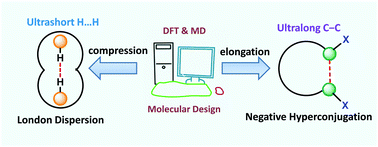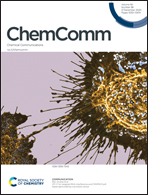Molecular designs for expanding the limits of ultralong C–C bonds and ultrashort H⋯H non-bonded contacts
Abstract
Recent experiments have reported the formation of very long C–C bonds (dC–C > 1.80 Å) and very short H⋯H non-bonded contacts (dH⋯H < 1.5 Å) in several sets of molecules. Both these rare phenomena arise due to specific donor–acceptor interactions and London dispersion interactions respectively. Favorable negative hyperconjugation, namely H2N(lone-pair) → σ*(C–C), creates an ultralong C–C bond in diamino-o-carborane with dC–C > 1.829 Å and a planar amine reminiscent of a transition-state like structure for ammonia inversion. The small and narrow barrier favours rapid inversion through quantum mechanical tunnelling (QMT) and produces a translationally averaged planar amine as observed in the experiments. On the other hand, designing specific confined molecular cavities or chambers like in,in-bis(hydrosilane) or its germanane analogs furnishes an ultrashort H⋯H distance = 1.47 Å and 1.38 Å respectively. The predisposition of such closely placed H⋯H contacts arises from the rather effective attractive dispersion interactions between them. Controlling the strength of the dispersion interactions provides a rich landscape for realizing such close H⋯H distances. Molecular design ably assisted by computational modeling to further tune these interactions provides new avenues to break the glass-ceilings of ultralong C–C bonds or ultrashort H⋯H contacts. Dispersion-corrected DFT calculations and ab initio molecular dynamics simulations generate a large library of such unique features in a diverse class of molecules. This feature article highlights the design principles to realize hitherto longest C–C bonds/shortest H⋯H contacts.



 Please wait while we load your content...
Please wait while we load your content...